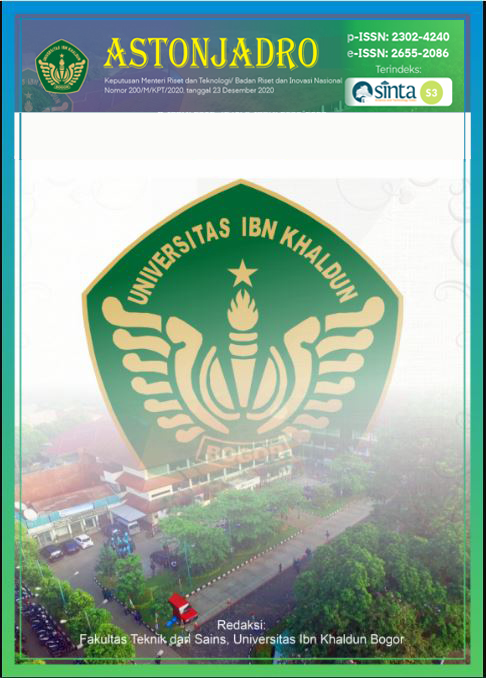Identification of the Causes Waste Material in the Railway Bridge Construction Project
DOI:
https://doi.org/10.32832/astonjadro.v13i2.14908Keywords:
materials; waste materials; construction project; railway bridge.Abstract
Material is one of the important components that has a close influence on the cost of a project, so with a large amount of construction material waste, it can be said that there is an overrun in the financing sector. In addition, the remaining construction materials can produce a high percentage of environmental pollution. Residual material or construction waste is something that is never separated from a project development. The existence of leftover materials can have a negative effect on the environment around the construction project. The remaining material can be interpreted as part of the material that has not been used resulting from the process of construction, repair, change or any item produced from the process, or an accident that cannot be directly used in that place without any further treatment. The railway bridge construction project certainly requires various types of materials, when viewed from the concept for the use of large materials, the more the remaining materials that exist or become construction waste. This research aims to determine the quantity of material waste generated from the construction of the railway bridge and analyze the factors that cause material waste in the railway bridge construction project. This research method uses observation and interview techniques and is supported by data obtained from the research location. The results of this study show that the largest percentage of waste cost during the railway bridge construction project came from K300 concrete material for retaining walls in the amount of 16.714% or Rp. 6,283,720.00. The source of the cause of the remaining material where the factors are generated from project actors, design, measurement/calculation, management, implementation and procurement/handling of materials.
References
Bossink, B. A. G. and Brouwers, H. J.H. 1996. Construction Aaste: Quantification and Source Evaluation. Journal of Construction Engineering and Management
Dipohusodo, Istimawan. 1996. Manajemen Proyek dan Rekonstruksi. Penerbit Kanisus. Yogyakarta
Ervianto, Wulfram. 2007. Manajemen Proyek Konstruksi. Andi Offset. Yogyakarta
Gavilan, RM. dan Bernold, LE. 1994. Source Evaluation of Solid Waste in Building Construction. Journal of Construction Engineering and Management
Goumans, J.J.J.M. Senden, G.J. van der Sloot, H.A. 1997. Waste Materials in Construction: Putting Theory into Practice. Elsevier Science
Gray, Clifford dan Erick W.L. 2007. Manajemen Proyek: Proses Manajerial. Andi Publisher. Yogyakarta
Winkler, Greg. 2010. Recycling Construction & Demolition Waste: A Leer_Based Toolkit (GreenSource). McGraw-Hill
Hartono, Widi. 2016. Analisis dan Identifikasi Sisa Material Konstruksi Pembanguan gedung Kantor dan Rumah Dinas kelurahan Gilingan, Jurnal Universitas Sebelas Maret Surakarta.
Hal Johnston, William R. Mincks. 1992. Waste Management for Construction Manager” part of the American Association of Cost Engineering. Morgantown
Haryadi, Darlan. 2018. Analisa Sistem Pengendalian Sisa material Pekerjaan Arsitektural Pada Proyek Konstruksi. Universitas Islam Indonesia. Yogyakarta
ICF Incorporated. 1995. Constuction and Demolition Waste Landfill. Prepared for EPA Office Of Solid Waste
Kusuma, Valentino. A. 2010. Evaluasi. Sisa material Pada Proyek Gedugn Pendidikan dan Laboratorium 8 Lantai Fakultas Kedokteran UNS Tahap 1. Universitas Sebelas Maret. Surakarta
Letcher, Trevor. M. dan Vallero, Daniel. A. 2011. Waste A Handbook for Management. Elsevier Science
Lauritzen, Erik. K. 2017. Construction Demolition and Disaster Waste Management an Intergrated and Sustainable Approach. CRC Press. Taylor and Francis
Nurhayati. 2010. Manajemen Proyek. Graha Ilmu, Yogyakarta
Project Management Institute, Inc. 2012. a Guide to the Project Management Body of Knowledge (PMBOK)
Purba, Derry. H. 2015. Analisis dan Pengelolaan Sisa material Konstruksi Dan Faktor Penyebab Pada 3 Proyek Kelurahan Ditinjau Bagian Pondasi Mengunakan Root Cause Analysis (RCA). Universitas Sebelas Maret. Surakarta
Rani, Hafnidar. 2016. Manajemen Proyek Konstruksi. Deepublish Publisher, Yogyakarta
Rukminingsih. Adnan, Gunawan dan Latief, Mohammad. A. 2020. Metode Penelitian Pendidikan Penetitian Kuantitatif, Penelitiaan Kualitatif, Penelitian Tindakan Kelas. Erhaka Art. Yogyakarta
Soeharto, Iman. 1999. Manajemen Proyek: dari Konseptual Sampai Operasional Jilid 1 dan 2. Erlangga. Jakarta.
Downloads
Published
How to Cite
Issue
Section
License
Copyright (c) 2024 ASTONJADRO

This work is licensed under a Creative Commons Attribution-ShareAlike 4.0 International License.
Paper submitted to ASTONJADRO is the sole property of the Astonjadro Journal. Unless the author withdraws the paper because he does not want to be published in this journal. The publication rights are in the journal Astonjadro.ASTONJADRO
LICENSE
This work is licensed under a Creative Commons Attribution-ShareAlike 4.0 International License.
Based on a work at http://ejournal.uika-bogor.ac.id/index.php/ASTONJADRO













